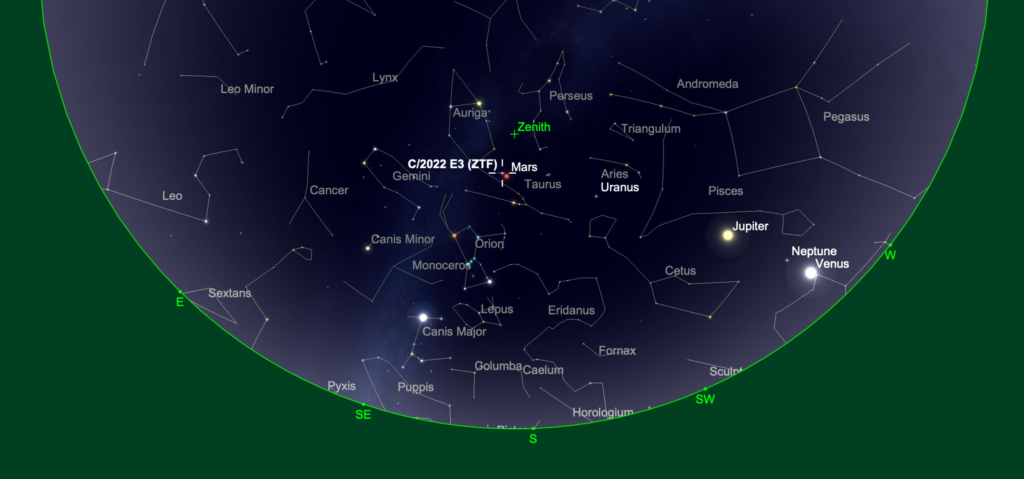Sky Report: February 6 – 12

The evening sky facing south 90 minutes after sunset on February 10. The comet is near Mars. Graphic created with
SkySafariAstronomy.com.
I hope everybody got a good look at Comet C/2022 E3 while it was at its brightest – while it was visible to the naked eye under a dark sky – because now it has left the earth and sun behind and is heading back to the depths of space. If you haven’t see it, it’s still there, fading slowly, easily visible in binoculars, where it’s nicely placed for early evening viewing high overhead, above Orion. The bad bright moon is out of the way and that makes a huge difference.
This week it moves through Auriga (Feb. 6-8) and Taurus (Feb. 9-Mar. 2). On the way it passes less than 2° from Mars on February 10 and 11 (expect some nice photos) and 1½° from Aldebaran and the edge of the famous Hyades Star Cluster on the 14th (expect more nice photos). Spotting something that is moving and changing is not a solitary event. Many of us will enjoy following its progress night-by-night as it traverses the winter constellations. How long will you be able to see it with your eyes alone? … with binoculars? … with a telescope? Google “comet c/2022 finder chart” if you don’t have a planetarium app.
Six months from now there will be zero planets in the evening sky; tonight there are three; don’t take them for granted. (Six months from now I’ll be fishing around for things to write about.)
The brightest of these three planets is Venus, poetically called the evening star. Venus is brilliant low in the west during evening twilight, and it sets two hours after the sun. How early can you see it? You can see it before sunset if you know where to look.
About 20° above Venus is the second-brightest planet, Jupiter. Jupiter is far larger than Venus but it’s four times as distant and so it’s only one-fifth as bright. Watch Venus approach Jupiter – their separation decreases noticeably night-by-night. By your own observations when do you estimate they’ll be closest (in conjunction)?
Last fall Mars rivaled Jupiter in brightness, but that was then. Mars is only twice the diameter of our moon but it’s 350 times as far as the moon, so it’s only one-seventh as bright as Jupiter. Jupiter’s distance from the earth changes only slightly during the year, but Mars’ distance changes a great deal when we catch and pass it, as we did in December, and then leave it behind, so watch Mars continue to fade as its distance increases. Compare its fading brightness to nearby stars.
Those stars near Mars are in Taurus, which is high overhead. Mars is 8° above the orange star Aldebaran. Tonight Mars is twice as bright as Aldebaran, but on April 1 it will equal Aldebaran in brightness. You can watch this happen; now you know what to look for.
You might spot Mercury very near to the eastern horizon a half-hour before sunrise, but you’ll need a low unobstructed horizon. This is for people who enjoy a challenge.
Stellar Vista Observatory provides portable telescopes and tripod mounted binocular kits on loan for free to residents and visitors in Kane County. Enhance your enjoyment of the night sky! For details or to request a loan, visit https://stellarvistaobservatory.org/discover-the-night-sky/ or drop in to the Kane County Office of Tourism.
The Sky Report is presented as a public service by the Stellar Vista Observatory, a nonprofit organization based in Kanab, Utah, which provides opportunities for people to observe, appreciate, and comprehend our starry night sky. Additional information is at www.stellarvistaobservatory.org. Send questions and comments to John@StargazingAdventures.org.






Comments are closed.